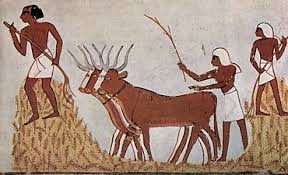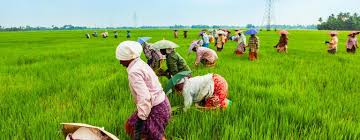Agriculture is one of the most significant developments in human history. It allowed people to shift from a nomadic lifestyle of hunting and gathering to settling in one place and cultivating crops and raising animals.
This transition not only changed how people lived but also shaped societies and cultures. In this article, we will explore the origins of agriculture, including the Neolithic Revolution, key developments in early agriculture, the domestication of plants and animals, and the impact of agriculture on human societies.
The Neolithic Revolution: A Turning Point
The Neolithic Revolution, which began around 10,000 BCE, marked a significant turning point in human history. It is often referred to as the “Agricultural Revolution” because it was during this time that humans transitioned from a hunter-gatherer lifestyle to settled farming communities.
1. Shift from Nomadic to Settled Life: Before the Neolithic Revolution, people moved frequently in search of food. The introduction of agriculture allowed them to settle in one location and establish permanent homes.
2. The Start of Farming: The cultivation of crops began in various regions worldwide, with evidence found in the Fertile Crescent, Mesoamerica, and East Asia. Early farmers grew grains like wheat, barley, and rice, which became staples in their diets.
3. Technological Innovations: The Neolithic Revolution also saw the development of tools for farming. Early farmers used simple tools like digging sticks and later advanced to sickles and plows, which improved crop production.
4. Population Growth: With a more stable food supply, populations began to grow. This increase in population led to the formation of villages and eventually cities.
5. Social Structure Changes: As communities grew, social structures became more complex. The division of labor emerged, with some people focusing on farming while others took on roles in trade, craftsmanship, or leadership.
Key Developments in Early Agriculture
Several key developments helped shape early agriculture and contributed to its success:
1. Crop Rotation: Early farmers discovered that rotating different crops in the same field improved soil fertility and increased yields. This practice allowed them to grow food more sustainably.
2. Irrigation Systems: In areas where rainfall was insufficient, farmers built irrigation systems to supply water to their crops. This innovation allowed agriculture to flourish in arid regions.
3. Selective Breeding: Farmers began selecting plants and animals with desirable traits for reproduction. This practice led to the development of high-yield crops and domesticated animals better suited for farming.
4. Storage Techniques: With surplus food production, early farmers developed storage techniques to preserve their harvests. They used granaries and clay pots to store grains, ensuring they had enough food during lean times.
5. Trade Networks: As agriculture developed, communities began to trade surplus food with neighboring groups. This trade fostered relationships between communities and led to the exchange of goods, ideas, and cultures.
Read Also Principles and Techniques in Livestock Breeding (Methods of Genetic Improvement)
Domestication of Plants and Animals

Domestication is the process of adapting wild plants and animals for human use. It was a crucial part of the agricultural revolution.
1. Domestication of Plants: Early farmers identified and cultivated wild plants that provided the best yields. They domesticated grains like wheat, barley, corn, and rice, which became staple foods.
2. Domestication of Animals: Animals such as goats, sheep, cattle, and pigs were domesticated for various purposes, including food, labor, and companionship. These animals provided meat, milk, wool, and help in farming tasks.
3. Impact on Biodiversity: The domestication process changed the genetic makeup of plants and animals. While it led to increased food production, it also reduced biodiversity, as farmers favored specific species over others.
4. Cultural Significance: Domesticated plants and animals became integral to the culture and daily life of early agricultural societies. They influenced diets, traditions, and even social practices.
5. Spread of Domestication: The knowledge and practice of domestication spread to different regions, leading to diverse agricultural practices and the development of various cuisines around the world.
Read Also Digestive Anatomy of Ruminants
Impact of Agriculture on Human Societies

Social Structures and Settlements
The advent of agriculture brought profound changes to human societies:
1. Formation of Permanent Settlements: As agriculture provided a stable food source, people began to establish permanent homes. These settlements grew into villages and cities, fostering social interactions.
2. Development of Social Hierarchies: With the division of labor, some individuals took on specialized roles, leading to the formation of social classes. Leaders, artisans, and farmers began to emerge, creating complex social structures.
3. Community Organization: Settled life encouraged the establishment of rules and governance. Communities developed systems for decision-making, resource allocation, and conflict resolution.
4. Increased Collaboration: As people settled, they needed to work together for farming, building, and protection. This cooperation led to stronger community ties and collective identity.
5. Cultural Exchange: Settlements facilitated cultural interactions, including the exchange of ideas, customs, and technologies, enriching the societies involved.
Economic Transformations and Trade
Agriculture transformed economies and trade practices:
1. Creation of Surplus Food: With efficient farming techniques, communities could produce more food than they needed. This surplus allowed for trade with neighboring groups.
2. Development of Markets: Surplus production led to the establishment of markets where goods were exchanged. This created opportunities for specialization and economic growth.
3. Rise of Craftsmanship: With farming providing a steady food supply, some individuals focused on crafting goods. This specialization led to the production of tools, pottery, and textiles.
4. Expansion of Trade Routes: As agriculture flourished, trade networks expanded, connecting different regions. This exchange of goods and ideas contributed to cultural and economic development.
5. Wealth Accumulation: Surplus food and trade created opportunities for wealth accumulation, leading to the emergence of social stratification and class differences.
Cultural and Technological Advances
The rise of agriculture spurred cultural and technological advancements:
1. Artistic Expression: With settled life, people could focus on artistic pursuits, leading to the creation of art, music, and literature. These expressions reflected their agricultural lifestyles and beliefs.
2. Technological Innovations: Agricultural needs drove innovations in tools and techniques. The invention of the plow, irrigation systems, and storage methods improved farming efficiency.
3. Development of Writing Systems: As societies grew, the need for record-keeping emerged. Writing systems developed to document trade, property ownership, and agricultural practices.
4. Cultural Traditions: Agriculture influenced cultural practices, such as festivals centered around planting and harvest seasons, shaping community identity.
5. Education and Knowledge Sharing: With settled life, knowledge about farming techniques and tools could be passed down through generations, fostering learning and education.
Challenges and Consequences of Agricultural Practices
Despite its many benefits, agriculture also brought challenges and consequences:
1. Environmental Degradation: Agricultural practices, such as deforestation and monoculture, led to soil depletion, loss of biodiversity, and habitat destruction.
2. Water Management Issues: Intensive farming increased water demands, leading to over-extraction of water sources and issues like salinization in some areas.
3. Health Issues: The shift to agriculture changed diets, sometimes leading to nutritional deficiencies. Close living conditions with domesticated animals also increased disease transmission.
4. Social Conflicts: As communities grew and resources became limited, conflicts over land and water access emerged. Competition for resources sometimes led to violence and warfare.
5. Economic Disparities: The rise of wealth and social stratification created economic disparities, where some individuals and groups accumulated wealth while others remained impoverished.
The origin of agriculture represents one of the most significant milestones in human history. The Neolithic Revolution marked the transition from a nomadic lifestyle to settled farming communities, leading to various developments in agriculture, such as crop rotation, irrigation, and selective breeding. The domestication of plants and animals shaped food systems and cultural practices.
Agriculture has had a lasting impact on human societies, transforming economies, social structures, and cultures. While it has contributed to advancements in technology and trade, it has also presented challenges related to environmental sustainability and social inequality. Understanding the origins and evolution of agriculture allows us to appreciate its role in shaping the world we live in today and the ongoing challenges and opportunities it presents for the future.
Do you have any questions, suggestions, or contributions? If so, please feel free to use the comment box below to share your thoughts. We also encourage you to kindly share this information with others who might benefit from it. Since we can’t reach everyone at once, we truly appreciate your help in spreading the word. Thank you so much for your support and for sharing!
Read Also How to Make Your Own Organic Pesticides

